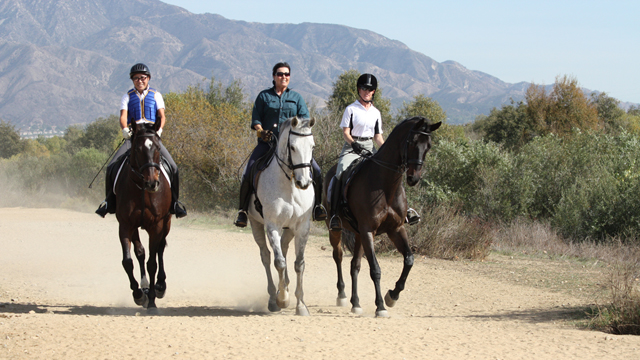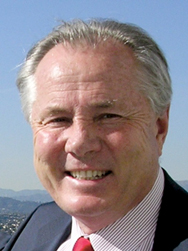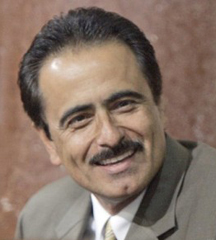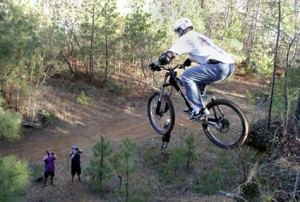L.A. Parks Ban on Biking Holds
By Lynn Brown April 19, 2011In the battle over Los Angeles city park trails, equestrians and hikers won a narrow 11th-hour victory over recreational mountain bikers. A March 1 vote by the city council effectively put the future of the city trails back under the purview of the Department of Recreation and Parks rather than the Department of Transportation, which was seeking to expand its reach beyond commuter biking.
Councilmembers Tom LaBonge and Richard Alarcón emerged the heroes of the hard-fought battle, which dragged on for 10 years and involved lobbyists, lawyers and consultants. Bicycling is prohibited on city park dirt trails by Los Angeles Municipal Code Section 63.44 B16. But bikers are permitted to recreate in county parks, and in 2000 the city spent $5 million to purchase Mandeville Canyon Park specifically for use by mountain bikers, who for safety reasons it was felt should be kept separate from horseback riders and hikers.
The high speeds, obstacle jumps and sharp turns of mountain biking, often labeled an “extreme sport,” is likely to spook horses and can also unsettle hikers. But that didn’t prevent an aggressive mountain biking contingent from trying to piggyback into the off-limits areas on the coattails of the city’s Bicycle Master Plan, a commuter bill designed to improve bicycle transportation throughout the city—primarily through the use of bike lanes in the streets and paved paths along the L.A. River.
With the L.A. Department of Transportation’s Bicycle Master Plan set to go before the council with language that was somewhat open-ended as to the possibility of mountain bikes on city trails, Alarcón took action, offering to make a motion on the floor of city council to have the mountain bike language removed from the Master Plan document and set aside for further study in Councilman LaBonge’s park trails committee.
But as it happened, Alarcón was out the week the bill went before the council, and LaBonge agreed to put the motion forward. But on the eve of the vote, after a special meeting and much negotiation, it was concluded that the City Planning Department and the council would not support complete removal of the mountain bike element from the Bicycle Master Plan. They did, however, agree to a change in the language in a way that made it much less onerous. It was amended to read:
“I hearby move that the 2010 Bike Plan be adopted with the following language to be amended as follows, Section 3.3.5 (Chapter 4, page 103):
Continue the existing off-road bicycle trail and analyze and explore opportunities for additional off-road bicycle facilities and continue to abide by the LAMC section 63.44 B16. Any proposal to consider the use of mountain bikes on park City trails must first be thoroughly reviewed and analyzed by the Board of Recreation and Parks and its staff.
That the “existing off road bike trail,” Mandeville Canyon Park, was referred to in the singular, not plural, was significant, as is the fact that Recreation and Parks is brought back into the decision-making loop in a meaningful way. The city council unanimously passed that motion, presented by LaBonge and Councilmember Ed Reyes.
Gerry Hans of the Oaks Homeowners Association remarked, “Sometimes we don’t celebrate enough when the victory isn’t perfect. While not the ‘no-hitter’ we had hoped for, it was a solid victory! The last-minute amendment that further defined Rec and Parks as the department in control of the trails use issue, was a last-minute triple, if not a home-run.”
The issue had been a long time brewing. In 1996, the Los Angeles Department of Transportation (LA DOT) and its Bicycle Advisory Committee (BAC) created a Master Plan for road bikes in Los Angeles. Included in that plan was a call to introduce mountain biking in Elysian Park. The plan would involve changing the ordinance (Los Angeles Municipal Code Section 63.44 B16) that prohibits bikes on the city parks’ dirt trails. (Mountain bikers are permitted in county parks.)
From 1999–2000, the L.A. Department of Recreation and Parks created a Mountain Bike Working Group, drawing on members of the biking, riding and hiking communities. Opposition to opening the city parks to mountain bikers was declared, and in short order the mountain bike lobby withdrew its participation. The remaining group members created a document composed of letters and reports from all over the U.S., called the Majority Report, and distributed it to each Los Angeles city council member. Soon thereafter, the city council unanimously voted against any change in the ordinance regarding bikes on dirt trails.
The issue would seem to have been put to rest, but the bikers were far from satisfied, and their lobbyists continued working behind the scenes. In February 2008 a series of public meetings was called, ostensibly to gather information from city park trail users as an aid in updating the L.A. Bicycle Master Plan. These public meetings were well attended by members of the community, the majority of them expressing overwhelming sentiment against putting bikes on trails with hikers, horses and other traditional users.
BAC, under the umbrella of the LA DOT, decided to update the Bicycle Master Plan, addressing the legitimate issues of commuter road biking (i.e., those who utilize the paved bike lanes on city streets). The idea was to improve safety measures, including better street lighting and more bike racks on buses. The mountain bikers managed to attach themselves to the plan, claiming that they were “commuters” too, but they wanted to commute on dirt trails.
Continuing their push for city park trails, in 2009 consultants from the Colorado-based Osprey Group were hired to promote mountain bike access on city trails, and LA DOT allowed the group to hold its own series of meetings, which included members of the equestrian hiking and mountain biking groups. Hikers and equestrians were united in their opposition, and no consensus was reached on the issue.
Also in 2009, a citywide “Needs Assessment” study was published. The study took a thorough look at all city parks and park users. The study included a comment from the American Sports Council, categorized mountain biking as an “extreme sport,” and also commented that interest in the activity seemed to be waning. The question was put to park patrons: What future improvements would you most like to see? Topping the list of thousands of responses was the addition of more hiking trails and paved bike paths along the streets and the L.A. River. Mountain biking was not listed.
In 2010 a final series of public meetings was held, attended by concerned park users. There were few, if any, mountain bikers present at these meetings, yet mountain biking language remained in the Bicycle Master Plan, a plot twist that did not go unnoticed. Hundreds of letters and e-mails, as well as public comment at meetings asked that the mountain biking element be removed (specifically, on the grounds that it is a recreational element, and does not belong in an LA DOT document).
In response, the Coalition for Safe Trails was formed to support the fact that this was not exclusively an equestrian issue; a variety of park users opposed bikes on dirt trails.
In early 2011 City Planning and the DOT held final meetings on the plan. The coalition and the public continued to push for removal of the mountain bike element from the Bike Master Plan. There was no cooperation from City Planning or DOT. Coalition members attended this meeting and brought a lawyer, Doug Carstens from Chatten-Brown & Carstens, a well-known environmental law firm. The coalition also hired government affairs consultant Morrie Goldman to help navigate the complicated issue.
Han of the Oaks Homeowners’ Association expressed appreciation for those who “wrote letters, sent e-mails and made phone calls as well as showing up in person to all the meetings over these last year.” He also extended a big thanks to the various environmental and equestrian groups that lent financial support, including the Coto Foundation.
Lynn Brown is national president of Equestrian Trails, Inc.
Short URL: https://theequestriannews.com/?p=477






